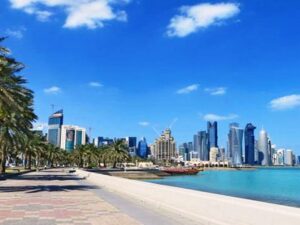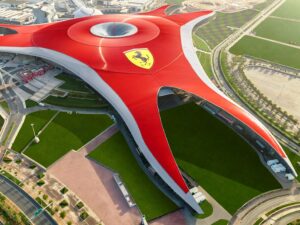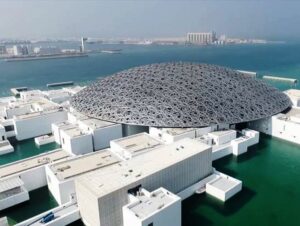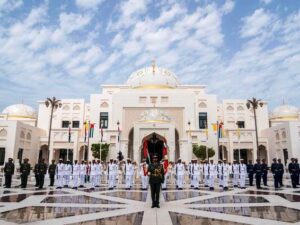‘2020’ Category
» posted on Sunday, August 14th, 2022 by Linda Lou Burton
Way Cool
Originally published August 9, 2020 by Linda Lou Burton posting about Cairo, Egypt and Reykjavik, Iceland from Little Rock, Arkansas – Fortunately I woke up from my Charlton Heston dream, it’s time to pack, and go. I must be thinking FAMILY today, getting excited about the grandkids that join me tomorrow in Reykjavik.
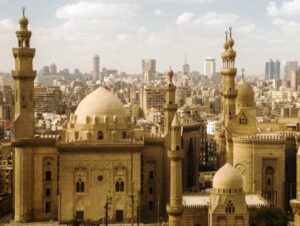 But I haven’t yet written anything really positive about Cairo. Like its designation as “city of a thousand minarets,” and the Old City, which includes the site of a Roman-era fortress and Islamic-era settlements pre-dating the founding of Cairo. Pretty awesome stuff, that you can only see right here; I should have planned longer to explore. There are cultural tours, historical tours, art tours, and even ghost tours. I’ve done the top rated suggestions – the Pyramids and the Nile cruise. But I haven’t mentioned the many parks in the city, or delved into the food scene at all.
But I haven’t yet written anything really positive about Cairo. Like its designation as “city of a thousand minarets,” and the Old City, which includes the site of a Roman-era fortress and Islamic-era settlements pre-dating the founding of Cairo. Pretty awesome stuff, that you can only see right here; I should have planned longer to explore. There are cultural tours, historical tours, art tours, and even ghost tours. I’ve done the top rated suggestions – the Pyramids and the Nile cruise. But I haven’t mentioned the many parks in the city, or delved into the food scene at all.  Most of the posh hotels offer five-star dining; and it’s cheaper here than in many countries. Lots of international choices – Spanish, Indonesian, Vietnamese, and traditional Egyptian of course; lots of rooftop and riverside dining if you don’t want to brave the bustling local spots. Looking for
Most of the posh hotels offer five-star dining; and it’s cheaper here than in many countries. Lots of international choices – Spanish, Indonesian, Vietnamese, and traditional Egyptian of course; lots of rooftop and riverside dining if you don’t want to brave the bustling local spots. Looking for  seafood, sushi, steak, or ful medames? Ful medames is a stew of fava beans, with garlic, onion, chili pepper and other vegetables; a staple in Egypt. Egyptian cuisine makes heavy use of legumes, vegetables, and fruit from the rich Nile Valley and Delta, similar to Eastern Mediterranean cooking. Rice-stuffed vegetables, grape leaves, kebabs; common meats are chicken and lamb. Tea is the national drink.
seafood, sushi, steak, or ful medames? Ful medames is a stew of fava beans, with garlic, onion, chili pepper and other vegetables; a staple in Egypt. Egyptian cuisine makes heavy use of legumes, vegetables, and fruit from the rich Nile Valley and Delta, similar to Eastern Mediterranean cooking. Rice-stuffed vegetables, grape leaves, kebabs; common meats are chicken and lamb. Tea is the national drink.
Cairo International (CAI); Egyptian Air this time, flying 2,000 miles north over Greece, Croatia, Austria, and Germany before a stop in Copenhagen, Denmark (CPH) for a few hours. Then 1,330 miles in a northwesterly direction over the the tip of Norway and the North Sea to Reykjavik, Iceland (KEF) and the biggest change on the entire trip.
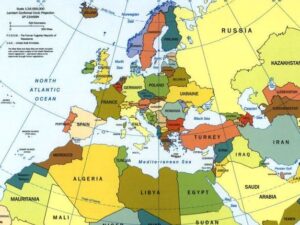 First of all, two of my grandkids arrive in the morning from Seattle; so the rest of the trip is “family time” instead of a singular experience. Then there is climate change, geography change, food change, and even “daylight” change – that far north we’ll have 17 hours of
First of all, two of my grandkids arrive in the morning from Seattle; so the rest of the trip is “family time” instead of a singular experience. Then there is climate change, geography change, food change, and even “daylight” change – that far north we’ll have 17 hours of 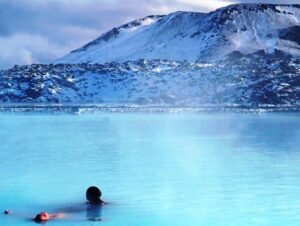 summer daylight to play. From the heat and humidity of Thailand and UAE and Egypt; from palm trees and monkeys and sand and camels; from Aboriginal and Buddhist and Islamic religions; from a generally hectic pace to the no-frills Lutheran way of life, where fish top every menu, swimming in geothermal pools is a year-round habit, and there’s not a poisonous snake to be found.
summer daylight to play. From the heat and humidity of Thailand and UAE and Egypt; from palm trees and monkeys and sand and camels; from Aboriginal and Buddhist and Islamic religions; from a generally hectic pace to the no-frills Lutheran way of life, where fish top every menu, swimming in geothermal pools is a year-round habit, and there’s not a poisonous snake to be found.
Just a wee bit south of the Arctic Circle – Reykjavik, Iceland, the northernmost capital city in the world. Way cool.
» posted on Saturday, August 13th, 2022 by Linda Lou Burton
Sly, and the Family Stone
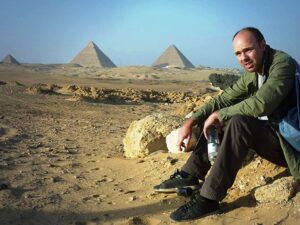 Originally published August 9, 2020 by Linda Lou Burton posting about Cairo, Egypt from Little Rock, Arkansas – Remember the 2010 TV show Idiot Abroad, where Ricky Gervais sent the bumbling Karl Pilkington around the world to see the Seven Wonders? The premise was that Karl knew nothing about “the Wonders” and much preferred staying home within his comfort zone. So how does such a person perceive what s/he sees when traveling? It was meant to be funny. And it was, it hit the charts. One episode was “Karl at the Pyramids.” Ricky pulled the strings; first Karl was made to ride round and round on a camel looking for the pyramids; then he visited a couple who believed aliens built the pyramids, so evening chanting with a sneak inside a pyramid. At the end Karl sits staring at the pyramids; they are crawling with tourists, and the wind is blowing dust and chunks of trash in swirls, right into his face. His comment: “Why is this a Wonder? All I see is dirty nappies flying round.”
Originally published August 9, 2020 by Linda Lou Burton posting about Cairo, Egypt from Little Rock, Arkansas – Remember the 2010 TV show Idiot Abroad, where Ricky Gervais sent the bumbling Karl Pilkington around the world to see the Seven Wonders? The premise was that Karl knew nothing about “the Wonders” and much preferred staying home within his comfort zone. So how does such a person perceive what s/he sees when traveling? It was meant to be funny. And it was, it hit the charts. One episode was “Karl at the Pyramids.” Ricky pulled the strings; first Karl was made to ride round and round on a camel looking for the pyramids; then he visited a couple who believed aliens built the pyramids, so evening chanting with a sneak inside a pyramid. At the end Karl sits staring at the pyramids; they are crawling with tourists, and the wind is blowing dust and chunks of trash in swirls, right into his face. His comment: “Why is this a Wonder? All I see is dirty nappies flying round.”
Ah, tourists. That story makes me think of what goes on at Uluru, with the “white ants climbing the rock.” And yes, the mad crush inside the giant cathedrals, and mosques, on my Portugal-Spain-Morocco guided tour last year. It was a mob-like push and shove, with photo ops. All timed, to fit the agenda before hopping back onto the bus.
The Pyramids at Giza, and the Great Sphinx have endured not only “the tourist crowd” for centuries, but destruction, pilfering, and theft, whether for research to explain them, or for profit, or simply because of a difference of opinion as to how things are in the world, or ought to be. Everyone has their version.
 Last night I had a vivid dream, I guess it came out of my NDI RTW “touristy” visit to the Pyramids, especially that garish evening light show. The dream was my own fictional version of these desert edifices. It’s pretty simple. The Pyramids are tombs, and the Sphinx is a grave stone. I have visited many cemeteries in my years of genealogy research. The size and design of grave stones varies according to the wealth of a family, and their beliefs. Angels? Tiny lambs for babies? I’ve seen stones with baseball bats and fishing rods engraved; or memorable quotes, like “Precious Mother,” or that funny one “I told you I was sick.”
Last night I had a vivid dream, I guess it came out of my NDI RTW “touristy” visit to the Pyramids, especially that garish evening light show. The dream was my own fictional version of these desert edifices. It’s pretty simple. The Pyramids are tombs, and the Sphinx is a grave stone. I have visited many cemeteries in my years of genealogy research. The size and design of grave stones varies according to the wealth of a family, and their beliefs. Angels? Tiny lambs for babies? I’ve seen stones with baseball bats and fishing rods engraved; or memorable quotes, like “Precious Mother,” or that funny one “I told you I was sick.”
 Think Charlton Heston now. Playing a powerful wealthy ruler, way back before Egypt was even Egypt. Long before he dies, he orders a mighty structure built in which to store everything he’ll need in the afterlife; plus the treasures he doesn’t want anyone else to have. As the worker bees in his reign cut the sandstone into blocks to build his magnificent FRP, and the quarry hole deepens, an ambitious young fellow seeking a promotion presents Charlton with an idea –“Let’s go ahead and sculpt your marker as we remove the stones for your tomb, what design would you like?” Charlton answers, “A big lion to guard my tomb, but a lion with my face on it, so everyone is fooled into thinking I still watch them.” “Ah, master, you are indeed a sly one,” the young fellow said, nodding. And so you have the Sphinx; on duty, sand and wind and tourists be hanged.
Think Charlton Heston now. Playing a powerful wealthy ruler, way back before Egypt was even Egypt. Long before he dies, he orders a mighty structure built in which to store everything he’ll need in the afterlife; plus the treasures he doesn’t want anyone else to have. As the worker bees in his reign cut the sandstone into blocks to build his magnificent FRP, and the quarry hole deepens, an ambitious young fellow seeking a promotion presents Charlton with an idea –“Let’s go ahead and sculpt your marker as we remove the stones for your tomb, what design would you like?” Charlton answers, “A big lion to guard my tomb, but a lion with my face on it, so everyone is fooled into thinking I still watch them.” “Ah, master, you are indeed a sly one,” the young fellow said, nodding. And so you have the Sphinx; on duty, sand and wind and tourists be hanged.
» posted on Friday, August 12th, 2022 by Linda Lou Burton
Time Will Tell
 Originally published August 8, 2020 by Linda Lou Burton posting about Cairo, Egypt from Little Rock, Arkansas – Giza is an Egyptian city on the west bank of the Nile, near Cairo. The Giza Plateau is home to iconic Egyptian monuments, including three tall pyramids built as royal mausoleums around the 26th century BC. The largest, the Great Pyramid, is King Khufu’s tomb. The Great Sphinx is a vast sculpture of a lion’s body with a human head. The site is at the edges of the Western Desert, approximately five miles west of the Nile River in the city of Giza, and about eight miles southwest of the city center of Cairo.
Originally published August 8, 2020 by Linda Lou Burton posting about Cairo, Egypt from Little Rock, Arkansas – Giza is an Egyptian city on the west bank of the Nile, near Cairo. The Giza Plateau is home to iconic Egyptian monuments, including three tall pyramids built as royal mausoleums around the 26th century BC. The largest, the Great Pyramid, is King Khufu’s tomb. The Great Sphinx is a vast sculpture of a lion’s body with a human head. The site is at the edges of the Western Desert, approximately five miles west of the Nile River in the city of Giza, and about eight miles southwest of the city center of Cairo.
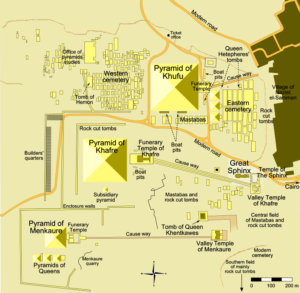 The Great Pyramid (Khufu) and the Pyramid of Khafre are the largest pyramids built in ancient Egypt, and they have historically been common as emblems of ancient Egypt in the Western imagination. The Great Sphinx of Giza is a limestone statue of a reclining sphinx, a mythical creature with the body of a lion and the head of a human. Facing directly from West to East, it is generally believed to represent the pharaoh Khafre.
The Great Pyramid (Khufu) and the Pyramid of Khafre are the largest pyramids built in ancient Egypt, and they have historically been common as emblems of ancient Egypt in the Western imagination. The Great Sphinx of Giza is a limestone statue of a reclining sphinx, a mythical creature with the body of a lion and the head of a human. Facing directly from West to East, it is generally believed to represent the pharaoh Khafre.
Freeze Frame
Hold on, hold on. There are encyclopedias, yea, libraries and museums, filled with theories and suppositions about what it all is, and what it means. Why were these structures built? Exactly when? And more to the question, exactly how? Their size, and endurance, defy explanation, based on what we know today about construction techniques, which we (foolishly?) believe have evolved over time. Today I’m not out to prove anything, or solve a mystery. I just want to SEE these awesome creations, especially the mysterious Sphinx, for myself. Writers and scholars over time have recorded their impressions and reactions upon seeing the Sphinx. A general description, often a mixture of science and mystique, is typical of what I have found; I particularly like this rather flowery one by John Lawson Stoddard, a writer who began traveling the world in 1874 and publishing books about his experiences:
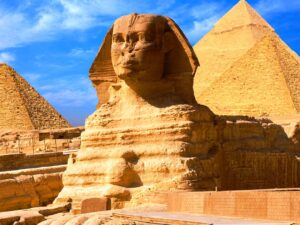 It is the antiquity of the Sphinx which thrills us as we look upon it, for in itself it has no charms. The desert’s waves have risen to its breast, as if to wrap the monster in a winding-sheet of gold. The face and head have been mutilated by Moslem fanatics. The mouth, the beauty of whose lips was once admired, is now expressionless. Yet grand in its loneliness, – veiled in the mystery of unnamed ages, – the relic of Egyptian antiquity stands solemn and silent in the presence of the awful desert – symbol of eternity. Here it disputes with Time the empire of the past; forever gazing on and on into a future which will still be distant when we, like all who have preceded us and looked upon its face, have lived our little lives and disappeared.
It is the antiquity of the Sphinx which thrills us as we look upon it, for in itself it has no charms. The desert’s waves have risen to its breast, as if to wrap the monster in a winding-sheet of gold. The face and head have been mutilated by Moslem fanatics. The mouth, the beauty of whose lips was once admired, is now expressionless. Yet grand in its loneliness, – veiled in the mystery of unnamed ages, – the relic of Egyptian antiquity stands solemn and silent in the presence of the awful desert – symbol of eternity. Here it disputes with Time the empire of the past; forever gazing on and on into a future which will still be distant when we, like all who have preceded us and looked upon its face, have lived our little lives and disappeared.
Forced to Be A Tourist
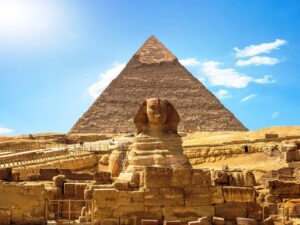 Even though the Sphinx is sitting there waiting for me, just eight miles from my hotel room, I am not renting a car and driving myself for the kind of leisurely visit I’d like to make. So I’ll play like a tourist, and wangle two back to back tours that maybe will allow me to feel as moved, on reflection, as Stoddard was.
Even though the Sphinx is sitting there waiting for me, just eight miles from my hotel room, I am not renting a car and driving myself for the kind of leisurely visit I’d like to make. So I’ll play like a tourist, and wangle two back to back tours that maybe will allow me to feel as moved, on reflection, as Stoddard was.
First the “half-day private tour with 30-minute camel ride” for the afternoon: Gain from the expertise and personalized attention of an Egyptologist as your guide to the Giza Plateau. Enjoy photo ops of the Great Sphinx and the Great Pyramid at Giza, one of the Seven Wonders of the Ancient World. Lunch and hotel transport by minivan are included. Entrance fees included.
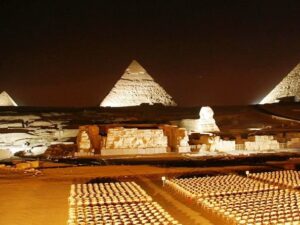 And then, for the evening, a “multimedia sound and light show”: See the world’s only surviving ancient wonder light up at night during this multimedia show. Sit in front of the Great Pyramids of Giza and listen to the history of ancient Egypt with image projections on the monument. Take photos of the projections during this 1-hour sound and light show and learn about ancient Egypt’s history spanning more than 5,000 years as you sit back and enjoy complimentary snacks. Round-trip transportation from your Cairo hotel.
And then, for the evening, a “multimedia sound and light show”: See the world’s only surviving ancient wonder light up at night during this multimedia show. Sit in front of the Great Pyramids of Giza and listen to the history of ancient Egypt with image projections on the monument. Take photos of the projections during this 1-hour sound and light show and learn about ancient Egypt’s history spanning more than 5,000 years as you sit back and enjoy complimentary snacks. Round-trip transportation from your Cairo hotel.
Will I remember the Cheetos, or the grandeur? Time will tell.
» posted on Thursday, August 11th, 2022 by Linda Lou Burton
But Who’s Counting?
Originally published August 7, 2020 by Linda Lou Burton posting about Cairo, Egypt from Little Rock, Arkansas – There are 81 cities in the world with a population over 5 million. Only 9 of those are in the US. I’ve been to them, and I’ve been to 6 of the ones outside the US. But I’ve never been to a city as large as Cairo. About 20,790,000 people live in the metro area, give or take a few. And over 9 million of those live downtown. Am I daunted by that? A little.
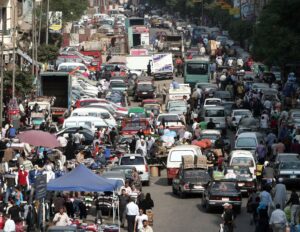 The negatives were considered when I plotted out my time here. Air pollution is serious. There are 4.5 million cars on Cairo streets, most of them old. And there are many unregistered lead and copper smelters in Cairo, major polluters. Because of the lack of rain, plus the city’s layout of tall buildings and narrow streets, which create a bowl effect, the dispersion factor is poor. A permanent haze over the city with particulate matter three times normal causes serious respiratory diseases and eye irritations; it is estimated that between 10 to 25 thousand deaths related to air pollution occur in a year; tourists need to take extra care. Another caution: Cairo is considered one of the most dangerous cities in the world for women; 99% of women living here report they have been sexually harassed, though new national laws define and criminalize those behaviors.
The negatives were considered when I plotted out my time here. Air pollution is serious. There are 4.5 million cars on Cairo streets, most of them old. And there are many unregistered lead and copper smelters in Cairo, major polluters. Because of the lack of rain, plus the city’s layout of tall buildings and narrow streets, which create a bowl effect, the dispersion factor is poor. A permanent haze over the city with particulate matter three times normal causes serious respiratory diseases and eye irritations; it is estimated that between 10 to 25 thousand deaths related to air pollution occur in a year; tourists need to take extra care. Another caution: Cairo is considered one of the most dangerous cities in the world for women; 99% of women living here report they have been sexually harassed, though new national laws define and criminalize those behaviors.
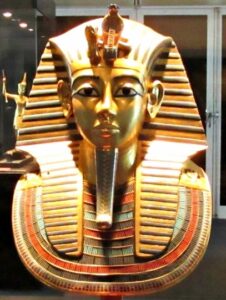 Still, I am here, and I always focus on the positives. On the plus side of things, this city is bubbling over with history. Founded in 969, it’s pretty young when you consider that just 9 miles to the west sits the Sphinx, which some Egyptologists believe is at least 4,500 years old. And then there’s all that King Tut stuff here in Cairo museums, remnants of ancient civilizations. But I didn’t come for that. I came for two specific reasons: to see the Great Pyramid of Giza, one of the constructed Wonders of the World. And I came because of the River Nile. Of course, Cairo does happen to be a capital city as well! And I am counting.
Still, I am here, and I always focus on the positives. On the plus side of things, this city is bubbling over with history. Founded in 969, it’s pretty young when you consider that just 9 miles to the west sits the Sphinx, which some Egyptologists believe is at least 4,500 years old. And then there’s all that King Tut stuff here in Cairo museums, remnants of ancient civilizations. But I didn’t come for that. I came for two specific reasons: to see the Great Pyramid of Giza, one of the constructed Wonders of the World. And I came because of the River Nile. Of course, Cairo does happen to be a capital city as well! And I am counting.
Cairo sits mostly on the east bank of the Nile, and almost at the end of the river’s 4,160-mile journey from south of the equator to the Mediterranean Sea. Yes, it flows northward, and its 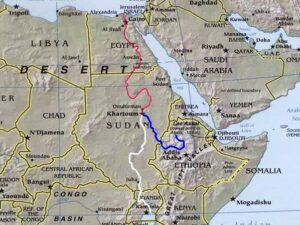 basin includes parts of Tanzania, Burundi, Rwanda, the Democratic Republic of the Congo, Kenya, Uganda, Ethiopia, Sudan, and the cultivated part of Egypt. I’ll go with what most geographers say about its beginnings; the Blue Nile comes from Lake Tana in Ethiopia and the White Nile from Lake Victoria in Tanzania; they converge at Khartoum in the Sudan
basin includes parts of Tanzania, Burundi, Rwanda, the Democratic Republic of the Congo, Kenya, Uganda, Ethiopia, Sudan, and the cultivated part of Egypt. I’ll go with what most geographers say about its beginnings; the Blue Nile comes from Lake Tana in Ethiopia and the White Nile from Lake Victoria in Tanzania; they converge at Khartoum in the Sudan 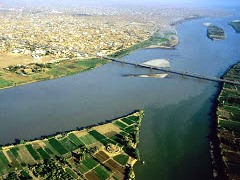 where the waterway becomes the “Nile,” which in ancient Egyptian means “great river.” It winds and twists its way into Egypt where it meets the Aswan Dam, built in the 1960s; an embankment dam that has produced both positive and negative benefits, as any effort to control nature generally does. Massive amounts of electricity, increasing water resources, and flood control – good; decrease in the fertility of agricultural lands in the delta – bad. Those floods deposited millions of tons of silt each year, nature’s way of fertilizing without chemicals. The building of the dam also impacted the ancient cities and temples along the river; controversy there.
where the waterway becomes the “Nile,” which in ancient Egyptian means “great river.” It winds and twists its way into Egypt where it meets the Aswan Dam, built in the 1960s; an embankment dam that has produced both positive and negative benefits, as any effort to control nature generally does. Massive amounts of electricity, increasing water resources, and flood control – good; decrease in the fertility of agricultural lands in the delta – bad. Those floods deposited millions of tons of silt each year, nature’s way of fertilizing without chemicals. The building of the dam also impacted the ancient cities and temples along the river; controversy there.
So how could I get myself on this river? There are many cruises available; most are south of Cairo, on luxury boats with stops allowing “visits to ancient civilizations” while carefully  avoiding the Nile crocodile. A 12-day Viking cruise beginning and ending in Cairo sounded enticing. Let your imagination soar as your ship meanders through panoramic desertscapes, fertile farmlands, colorful villages and UNESCO World Heritage Sites that preserve the ancient glory of Egypt’s greatest temples, palaces and tombs. Included excursions in every port reveal highlights like these:
avoiding the Nile crocodile. A 12-day Viking cruise beginning and ending in Cairo sounded enticing. Let your imagination soar as your ship meanders through panoramic desertscapes, fertile farmlands, colorful villages and UNESCO World Heritage Sites that preserve the ancient glory of Egypt’s greatest temples, palaces and tombs. Included excursions in every port reveal highlights like these:
- Luxor’s Karnak Temple complex
- The Necropolis of Thebes, Egypt’s largest repository of pharaonic tombs
- Luxor Temple, with its sphinx-lined avenue
- Privileged Access to the tomb of Nefertari in the Valley of the Queens
- The graceful temple of Hatshepsut, Egypt’s only female pharaoh
- The temple of Hathor at Dendera
- The romantic, waterbound Temple of Isis at Philae
- Horse-drawn calèche tour to Edfu’s Temple of Horus
I didn’t have time for all of that! I just wanted to cruise the Nile.
 So I settled for an evening dinner cruise in Cairo with pickup from my hotel. Itinerary, their translation: Sun Pyramids Tours will pick you up from your hotel and transfer to Nile Pharaoh Dinner Cruise dock. Embark the famous Cairiane cruises which resembles a pharaonich barge with tribute to ancient Egyptian god Hathor. From the deck you can take panoramic views of Cairo skyline at the evening. Enjoy a sumptuous international buffet dinner with variety of Egyptian and international cuisine and desserts. Live performances of belly dance, and tanura the sufi meditation whirling dervish shows will take place while you are having dinner. After dinner you can again rise to the deck to enjoy the air breeze of the Nile and take in the marvelous glittering sights of Cairo as the boat returns back to the dock. Upon arrival you will be transferred back to your hotel.
So I settled for an evening dinner cruise in Cairo with pickup from my hotel. Itinerary, their translation: Sun Pyramids Tours will pick you up from your hotel and transfer to Nile Pharaoh Dinner Cruise dock. Embark the famous Cairiane cruises which resembles a pharaonich barge with tribute to ancient Egyptian god Hathor. From the deck you can take panoramic views of Cairo skyline at the evening. Enjoy a sumptuous international buffet dinner with variety of Egyptian and international cuisine and desserts. Live performances of belly dance, and tanura the sufi meditation whirling dervish shows will take place while you are having dinner. After dinner you can again rise to the deck to enjoy the air breeze of the Nile and take in the marvelous glittering sights of Cairo as the boat returns back to the dock. Upon arrival you will be transferred back to your hotel.
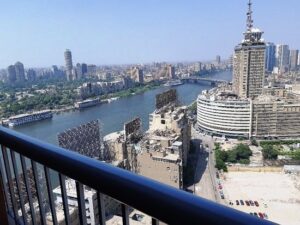 I expect my head will be whirling like that dervish by the time I get to bed. But my room does overlook the Nile; and my view stretches far across this busy whirling city that has 4.5 million horn-honking cars. There may be too much pollution and too much commotion, but tomorrow I have an entire day to hang out with the Sphinx and touch the Pyramid of Giza. And I will have cruised the Nile, just think how much of Africa its waters have touched!
I expect my head will be whirling like that dervish by the time I get to bed. But my room does overlook the Nile; and my view stretches far across this busy whirling city that has 4.5 million horn-honking cars. There may be too much pollution and too much commotion, but tomorrow I have an entire day to hang out with the Sphinx and touch the Pyramid of Giza. And I will have cruised the Nile, just think how much of Africa its waters have touched!
Pluses, and minuses, but who’s counting?
» posted on Wednesday, August 10th, 2022 by Linda Lou Burton
Come Fly With Me
Originally published August 7, 2020 by Linda Lou Burton posting about Cairo, Egypt from Little Rock, Arkansas – Hurry, hurry, zip the suitcase, check out. Today’s flight isn’t too bad, just a few hours. I’m flying Ethiad again, I didn’t realize when I booked my flight that they are headquartered in Abu Dhabi, right by the International Airport. It’s 1,480 miles from there to Cairo International (CAI) and then another 13 miles to my hotel, the Ramses Hilton. I’ll be flying over Qatar, Saudi Arabia, and maybe Jordan and the Suez Canal.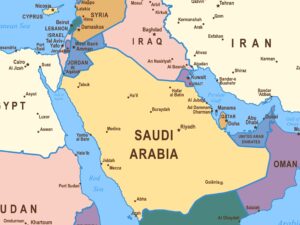
I’m not leaving Abu Dhabi till 2:30 this afternoon, so I have time to do just a little more looking around this blindingly bright city that sits beside this incredibly blue water. As usual, I hate to leave where I am. I wish I had another week, at least.
But guess what. I’m booked for an evening dinner cruise on the Nile tonight. That’s the longest river in Africa, remember?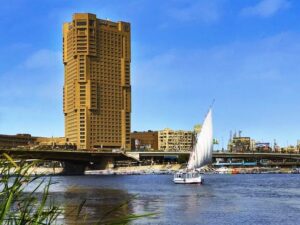
» posted on Tuesday, August 9th, 2022 by Linda Lou Burton
Just Wanna Have Fun
 Originally published August 6, 2020 by Linda Lou Burton posting about Abu Dhabi, United Arab Emirates from Little Rock, Arkansas – What do you do for fun in Abu Dhabi? That was my question. I’ve seen the Grand Mosque where people worship, the Presidential Palace where government happens, and the skyscrapers where people work, and live. Now what? There are bus, boat, and seaplane tours that show you around; specific trips such as “island getaways,” or “desert dune rides.” Abu Dhabi is big on shopping, so lots of fancy malls. But first, I checked out the food scene.
Originally published August 6, 2020 by Linda Lou Burton posting about Abu Dhabi, United Arab Emirates from Little Rock, Arkansas – What do you do for fun in Abu Dhabi? That was my question. I’ve seen the Grand Mosque where people worship, the Presidential Palace where government happens, and the skyscrapers where people work, and live. Now what? There are bus, boat, and seaplane tours that show you around; specific trips such as “island getaways,” or “desert dune rides.” Abu Dhabi is big on shopping, so lots of fancy malls. But first, I checked out the food scene.
Food
 I didn’t know what foods to expect in the United Arab Emirates; here is what I found: restaurants seem to cover all the bases – Chinese, Japanese, Indian, Italian, Peruvian, and even traditional Emirati! Meat, fish, and rice are staples of the Emirati cuisine; lamb and mutton are more favored than goat, beef and camel. Dates are generally part of a meal; coffee and tea are supplemented with cardamom, saffron, or mint to give it a distinct flavor. I’m familiar with hummus and kebabs, but some menu items are new to me, such as machboos. That is a rice dish, with onions, spices, meat, and dried lemon peel; simmered till tender, a must do. Harees is one of the most popular traditional foods in the Emirati kitchen, especially during important family
I didn’t know what foods to expect in the United Arab Emirates; here is what I found: restaurants seem to cover all the bases – Chinese, Japanese, Indian, Italian, Peruvian, and even traditional Emirati! Meat, fish, and rice are staples of the Emirati cuisine; lamb and mutton are more favored than goat, beef and camel. Dates are generally part of a meal; coffee and tea are supplemented with cardamom, saffron, or mint to give it a distinct flavor. I’m familiar with hummus and kebabs, but some menu items are new to me, such as machboos. That is a rice dish, with onions, spices, meat, and dried lemon peel; simmered till tender, a must do. Harees is one of the most popular traditional foods in the Emirati kitchen, especially during important family  gatherings and special holidays. Put meat and wheat together in a “mash pan” with water and salt and cook for a long time (at least four hours), stirring with a wooden spoon called a “masad masr.” Sprinkle chopped fried onions on top. Eat! For breakfast, it’s balaleet, vermicelli sweetened with cardamom, saffron, and rose water, then topped with a thin egg omelet; or have a chebab, a pancake; or khameer, date-sweetened bread.
gatherings and special holidays. Put meat and wheat together in a “mash pan” with water and salt and cook for a long time (at least four hours), stirring with a wooden spoon called a “masad masr.” Sprinkle chopped fried onions on top. Eat! For breakfast, it’s balaleet, vermicelli sweetened with cardamom, saffron, and rose water, then topped with a thin egg omelet; or have a chebab, a pancake; or khameer, date-sweetened bread.
 A restaurant on the mainland and one on the beach caught my eye: Meylas – “childhood recipes crafted by Emirati mothers and grandmothers, locally sourced ingredients; décor offers a nostalgic look at the time of the Bedouins; gift items by Emirati artists for sale, and delicacies to take home, dates to mango pickles.” Mezlai – “local dishes, traditional recipes featuring staples from Emirati cuisine such as camel, dates, rosewater; furnished with Bedouin emblems, dallah tapestries, reminiscent of a Bedouin tent; a luxury setting in the Emirates Palace Hotel on the Corniche.
A restaurant on the mainland and one on the beach caught my eye: Meylas – “childhood recipes crafted by Emirati mothers and grandmothers, locally sourced ingredients; décor offers a nostalgic look at the time of the Bedouins; gift items by Emirati artists for sale, and delicacies to take home, dates to mango pickles.” Mezlai – “local dishes, traditional recipes featuring staples from Emirati cuisine such as camel, dates, rosewater; furnished with Bedouin emblems, dallah tapestries, reminiscent of a Bedouin tent; a luxury setting in the Emirates Palace Hotel on the Corniche.
The Corniche is a curving street along the edge of the beach, and what a street it is. Walking paths, cycle paths, fountains, parks, and of course, beach! Hotels and restaurants all along the way, my hotel is one of them; world famous skyscrapers like Etihad Towers and Landmark Tower; the Emirates Palace Hotel past the far end, near the Presidential Palace. Marina Mall can be accessed from here via a breakwater road; Lulu Island is a tiny reclaimed island.
Yas Island is 6,000 acres of “leisure island” stuff, with everything designed to exhaust you by the end of the day. For just “playing” there is Ferrari World, Warner Brothers World and Waterworld; for sports there is the Yas Marina Circuit, Yas Links, and Yas Beach, as well as charter boats for hire. Get to Yas Mall via Yas Express, service right to the shopping door. If you like Disney, go to Abu Dhabi soon. Three spots you’ll probably choose:
- Ferrari World, a mostly indoors amusement park in the largest frame structure ever built. Formula Rossa, the world’s fastest roller coaster is here; in all there are five roller coasters, and yes, you can drive a Ferrari here. Find That Ferrari Feeling https://www.ferrariworldabudhabi.com/
- Warner Brothers World is another indoor amusement park, fully air conditioned, remember, it’s hot in Abu Dhabi. Six themed areas: Gotham City, Metropolis, Cartoon Junction, Bedrock, Dynamite Gulch and Warner Brothers Plaza. https://www.wbworldabudhabi.com/
- Yas Waterworld is NOT indoors, it is spread over 37 acres, has 40 rides, and calls itself “the ultimate water adventure.” Slithering slides promised. https://www.yaswaterworld.com/en
I pass on all of the above, because I’m a slow-moving gal. But I’m intrigued by the serenity at Abu Dhabi’s Louvre. Yes, the “other” Louvre is in Paris, but the planners in Adu Dhabi paid $525 million for the use of the Louvre brand name, and many millions more will be paid over the years for the loan of artworks, plus management advice. The Abu Dhabi Louvre is a collection of galleries, pavilions, lagoons, and plazas covered by a gigantic mashrabiya-inspired dome, which appears to float above it all, an “oasis,” where people can gather, mingle, and be enthused by art. The most expensive painting in the world goes on display September 18; Salvator Mundi, a masterpiece by da Vinci. It was acquired by the Abu Dhabi Department of Culture & Tourism for $450.3 million. https://www.louvreabudhabi.ae/en
The Abu Dhabi Falcon Hospital is the world’s first and largest hospital dedicated to the Falcon, the UAE’s national bird. Falconry was traditionally a means to hunt meat; life was difficult in the desert and falcons were essential to the survival of Bedouin families. But falconry is also a sport that goes back 3,000 years, and guided tours of the facility provide insight into the history of the sport, and the physiology of this significant bird.On tour you can see the birds swoop through a free-flight aviary, witness a falcon pedicure, and even make friends with a bird perched on your arm. The Falcon Hospital has 200 treatment rooms where about 6,000 birds are treated year each year, coming from UAE, Saudi Arabia, Qatar, Kuwait and Bahrain. https://www.falconhospital.com/
The Falcon Hospital is a “déjà vu” for me. I visited Birds of Prey near Boise, Idaho in May 2012. Sheik Zayed’s son funded the building and everything in it, asking only that it be named in honor of his father. And now I’m here in Abu Dhabi on my NDI RTW! Read about Boise’s falcons, and Sheik Zayed’s impact on Idaho: https://capitalcitiesusa.org/?p=1799#more-1799
» posted on Monday, August 8th, 2022 by Linda Lou Burton
Things Are Looking Up
Originally published August 6, 2020 by Linda Lou Burton posting about Abu Dhabi, United Arab Emirates from Little Rock, Arkansas – I love saying Abu Dhabi out loud. What a great sound it has! Its meaning is pretty too, “Abu” is Arabic for father, and “Dhabi” is the Arabic word for gazelle. Abu Dhabi – 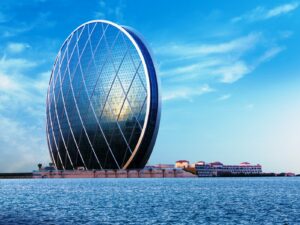 Father of Gazelle. It is thought this name came about because of the abundance of gazelles in the area. Those gazelles have long since been replaced by people – the population has grown in the last 60 years from 25,000 to 1.5 million! And skyscrapers you would not believe. Some of the tallest buildings on the skyline include the 1,253 ft Central Market Residential Tower, the 1,063 ft Landmark, and the 74-story 1,017 ft Sky Tower. And not just tall, but unique, the Aldar Headquarters was the first circular skyscraper in the Middle East. Because of its coin shape, it is called the Dirham building, after the Emirati currency.
Father of Gazelle. It is thought this name came about because of the abundance of gazelles in the area. Those gazelles have long since been replaced by people – the population has grown in the last 60 years from 25,000 to 1.5 million! And skyscrapers you would not believe. Some of the tallest buildings on the skyline include the 1,253 ft Central Market Residential Tower, the 1,063 ft Landmark, and the 74-story 1,017 ft Sky Tower. And not just tall, but unique, the Aldar Headquarters was the first circular skyscraper in the Middle East. Because of its coin shape, it is called the Dirham building, after the Emirati currency.
Abu Dhabi’s rapid development and urbanization, coupled with its massive oil and gas reserves and relatively high average income, have transformed it into a large, developed metropolis. It is the capital and the second-most populous city of the United Arab Emirates (after Dubai), and accounts for about two-thirds of the $400 billion UAE economy. Abu Dhabi sits on an island in the Persian Gulf, though most of the city and the Emirate reside on 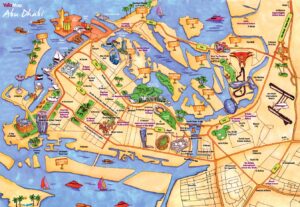 the mainland connected to the rest of the country. I’m one of the lucky ones waking up on the island this morning. My hotel, the Marriott St Regis, is another one of the “tall unusual”
the mainland connected to the rest of the country. I’m one of the lucky ones waking up on the island this morning. My hotel, the Marriott St Regis, is another one of the “tall unusual” 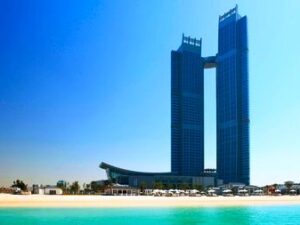 buildings in Abu Dhabi, and I have never been so close to luxury’s lap. See the “connector” between the two towers? That is the 3-bedroom private suite with its own elevator to the 46th floor and a view to die for. That’s not my room, (chuckle, I left my
buildings in Abu Dhabi, and I have never been so close to luxury’s lap. See the “connector” between the two towers? That is the 3-bedroom private suite with its own elevator to the 46th floor and a view to die for. That’s not my room, (chuckle, I left my 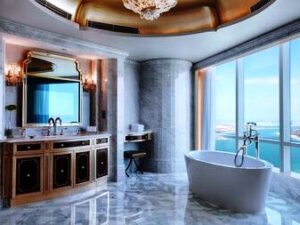 helicopter back home), but my view is pretty darn spectacular, looking out over the Persian Gulf; for pete’s sake, just look at my bathroom!
helicopter back home), but my view is pretty darn spectacular, looking out over the Persian Gulf; for pete’s sake, just look at my bathroom!
I’d stay right here at this hotel all day long, except, I am dying to see the skyscrapers here, and I have to visit the Presidential Palace. It’s just down the street, and as of last year, is open for public visits. It is called “Qaṣr Al-Waṭan” in Arabic, meaning “Palace of the Nation” and is ranked among the top 20 landmarks of art and culture in the world. It could be called “The White House” – its façade is white granite and limestone, intricately designed and ornately decorated. It includes a dome with a diameter of 121 ft, and a  chandelier with 350,000 pieces of crystal. The dome is located on top of the central chamber known as “The Great Hall,” which is surrounded by two wings to the east and west.
chandelier with 350,000 pieces of crystal. The dome is located on top of the central chamber known as “The Great Hall,” which is surrounded by two wings to the east and west.
The eastern wing has the “House of Knowledge,” where a number of artifacts and other objects of importance are stored, such as gifts presented by visiting officials from other countries, religious texts (the Quran and the Bible), and a library with more than 50,000 books which document the cultural, social and political history of the country. The western wing is used for official purposes. Meetings of the UAE Cabinet and Federal Supreme Council, and summits of international bodies like the Organisation of the Islamic Conference, Arab League, and Gulf Cooperation Council are held here in a room known as the “Spirit of Collaboration.”
I’m going to point out just a few more skyscrapers; the Etihad Towers are near the Palace; five towers keeping company, do they look like swaying grass or trees against the skyline to you? Two of the towers are connected by a walkway on the 75th floor.
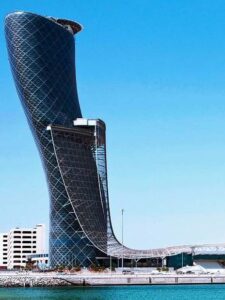 The Capital Gate, just on down the road a way, is referred to as the “Leaning Tower of Abu Dhabi,” and holds the Guinness World Record for the “world’s furthest-leaning man-made tower.” Completed in 2011, it is also the Middle East’s first building to use a material-saving diagrid form.
The Capital Gate, just on down the road a way, is referred to as the “Leaning Tower of Abu Dhabi,” and holds the Guinness World Record for the “world’s furthest-leaning man-made tower.” Completed in 2011, it is also the Middle East’s first building to use a material-saving diagrid form.
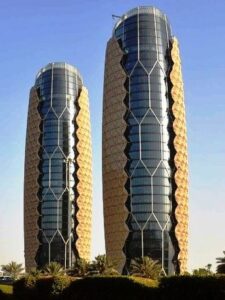 And when it comes to design, look at the twin, 29-story Al Bahr Towers riff on the traditional Arabian mashrabiya (geometric window coverings) as an ingenious energy-saving measure; the windows react automatically to the sun, expanding to provide shade and reduce the need for air conditioning. This one was completed in 2013.
And when it comes to design, look at the twin, 29-story Al Bahr Towers riff on the traditional Arabian mashrabiya (geometric window coverings) as an ingenious energy-saving measure; the windows react automatically to the sun, expanding to provide shade and reduce the need for air conditioning. This one was completed in 2013.
I’ll tell you what I discover about the food, and the other sights I see in a later post. Right now I’m a little dizzy from all that looking up.
» posted on Sunday, August 7th, 2022 by Linda Lou Burton
Checking In On Reality
Originally published August 6, 2020 by Linda Lou Burton posting from Little Rock, Arkansas – A reality check today, before I talk about my wonderful visit to Abu Dhabi.
It is clear, I hope, that all my travel posts are strictly imaginary. Imaginary, however, only due to COVID-19. This was to be a full-fledged Round The World trip celebrating 81 years of life,  and I had booked all the hotels I mention in my posts, and selected all my flights. I carefully routed myself for the shortest in-air time possible, over the least amount of water. I’m not good at sitting in a tube with a belt buckled over my lap for more than six hours! So I meticulously planned.
and I had booked all the hotels I mention in my posts, and selected all my flights. I carefully routed myself for the shortest in-air time possible, over the least amount of water. I’m not good at sitting in a tube with a belt buckled over my lap for more than six hours! So I meticulously planned.
But “life happens while you’re making other plans” fell true this March, when world travel was shut down in a hurry. So I consoled myself by declaring I’d imagine the trip, and think myself there. I renamed it the Now Defunct Imaginary Round The World (NDI RTW), and I started writing. After Abu Dhabi I go to Cairo, and cruise the Nile; then Reykjavik, Iceland, the northernmost capital city in the world! Get it? Wellington, and Reykjavik? My two high-school-graduate grandchildren are (were) meeting me there, and then a flight to Washington, DC together for a rousing end to an RTW, and finally a grand celebration back in Little Rock.
As of this week, the Center for Disease Control reports 4,678,610 cases of COVID-19 in the United States.
The World Health Organization reports 18,614,177 cases of COVID-19 worldwide.
I checked on current travel restrictions in the countries on my RTW, info from the US State Department, the agencies within countries, and the airlines. Here goes:
New Zealand
The New Zealand borders are closed for all but critical travel — protecting public health in New Zealand is paramount. The travel ban applies to all arrivals into New Zealand whether it is by air or sea. To help stop the spread of COVID-19, people who do arrive in New Zealand are required to undergo either managed isolation or quarantine for at least 14 days. https://covid19.govt.nz/travel-and-the-border/border-restrictions/#border-entry-restrictions
Australia
Australia’s borders are closed. Only Australian citizens, residents and immediate family members can travel to Australia. Australian Border Force liaison officers will work with airlines at overseas airports to identify those who should not board flights to Australia. https://www.health.gov.au/news/health-alerts/novel-coronavirus-2019-ncov-health-alert/coronavirus-covid-19-restrictions/coronavirus-covid-19-advice-for-international-travellers#travel-into-australia
Thailand
Updated 01st of August 2020: The Civil Aviation Authority in Thailand decided to extend the restrictions concerning commercial flights arriving in Thailand (with some exceptions) until 31th of August 2020. https://www.thaiairways.com/en_SE/news/news_announcement/news_detail/coronavirus.page
United Arab Emirates
The UAE government announced travelers must have a negative COVID-19 test result before flying to the country. The National Crisis and Emergency Management Authority (NCEMA) said all travelers, including Emiratis, residents, tourists, and transit passengers, must have a negative COVID-19 PCR (nasal swab) test result within 96 hours in order to board commercial flights to the UAE. NCEMA said the new system will be in place August 1. However, there are reports Etihad and Emirates airlines began implementing this new regulation on July 24. https://ae.usembassy.gov/u-s-citizen-services/covid-19-information/
Egypt
As of the evening of August 5, there were 94,875 confirmed cases of Covid-19 and 4,930 deaths in Egypt. Egypt is implementing 14-day quarantine periods and other preventative measures in all cases. https://eg.usembassy.gov/u-s-citizen-services/covid-19-information/
Iceland
As of 31 July, passengers arriving in Iceland who intend to stay in Iceland for 10 days or more have to undergo 2 COVID tests. The first is at the border on arrival and the second by the primary healthcare service 4-6 days later. In between the two tests, special precautions need to be taken. https://www.icelandair.com/support/covid-19/faq
Washington DC
As of July 24, if you are out in DC, you are required to wear a mask, with a few exceptions for vigorous exercise or while you’re actively eating or drinking. A self-quarantine of 14 days is required after participating in non-essential travel to/from high-risk areas when returning or traveling to Washington, DC, beginning July 27. The list of high-risk states included in the Mayor’s order are below and are in effect until Monday, Aug. 10.
- Arkansas
- Arizona
- Alabama
- California
- Delaware
- Florida
- Georgia
- Idaho
- Iowa
- Kansas
- Louisiana
- Mississippi
- Missouri
- Montana
- Nebraska
- Nevada
- New Mexico
- North Carolina
- North Dakota
- Ohio
- Oklahoma
- South Carolina
- Tennessee
- Texas
- Utah
- Washington
- Wisconsin
There you have it.
» posted on Saturday, August 6th, 2022 by Linda Lou Burton
Old Time Religion
Originally published August 5, 2020 by Linda Lou Burton posting about Abu Dhabi, United Arab Emirates from Little Rock, Arkansas – Today is moving day – I leave Bangkok to go to Abu Dhabi, capital of United Arab Emirates. My 3,100-mile Ethiad Airlines flight takes me over the tip of Myanmar, the Bay of Bengal, the widest part of India, and the Arabian Sea before a plane change in Muscat, Oman’s capital city.  I arrive at the Abu Dhabi International Airport (AUH) at 3:05 and head for the Marriott St Regis where my room overlooks the Persian Gulf. And I exchange a view of golden stupas for white domed mosques. It was an adjustment coming to Bangkok, a city where there are more people per square mile than I’ve ever experienced, but I had friends from Thailand; I knew the people, and loved the food, even if I didn’t speak the language. I have never met a single person from the UAE; I don’t know the language, and I have no idea as to what to expect in this Middle Eastern country. That is why I chose to visit. I have a lot to learn. Where to start?
I arrive at the Abu Dhabi International Airport (AUH) at 3:05 and head for the Marriott St Regis where my room overlooks the Persian Gulf. And I exchange a view of golden stupas for white domed mosques. It was an adjustment coming to Bangkok, a city where there are more people per square mile than I’ve ever experienced, but I had friends from Thailand; I knew the people, and loved the food, even if I didn’t speak the language. I have never met a single person from the UAE; I don’t know the language, and I have no idea as to what to expect in this Middle Eastern country. That is why I chose to visit. I have a lot to learn. Where to start?
Waking up this morning in Bangkok, a city filled with Buddhist temples (wats) and going to sleep tonight in Abu Dhabi, a city filled with Islamic mosques, got me thinking about religion. Religions need “places to worship and practice,” hence, belief systems impact architecture; and so, it follows, the “look” of a country. I already understand the basic design features and symbols standard to Christian churches and cathedrals. But I don’t know why wats and mosques look the way they do. So I read about them; listen up.
Architecture of a Wat
The Sangkhawat contains the monks’ living quarters and lies within the wall surrounding the temple compound. The Phutthawat is the area dedicated to Buddha and contains several buildings.
 Ho rakhang, a bell tower used for waking the monks and announcing morning and evening ceremonies
Ho rakhang, a bell tower used for waking the monks and announcing morning and evening ceremonies- Chedi or Stupa in the form of a bell-shaped tower covered with gold leaf, containing a relic chamber
- Ubosot or Bot, the ordination hall and most sacred area
- Wihan, a shrine hall that contains the principal Buddha images and where monks and laypeople congregate
- Sala kan parian, a large, open hall where laity can hear sermons or receive religious education, also used for chanting afternoon prayers
- Sala, an open pavilion providing shade and a place to rest
- Phra rabiang, a peristyle built around the sacred inner area as a cloister
- Ho trai, the temple library or sacred scriptures depository
- Ancillary buildings such as a school
Certain symbols allude to different aspects of the Buddhist religion. One is the four-armed figure of Vishnu; another is the Naga, deities which may appear as a snake, dragon or cobra.
The Wat Pho in Bangkok
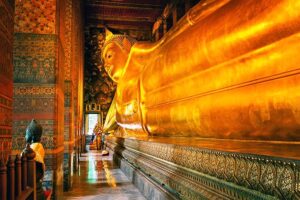 Wat Pho is one of the largest wats in Bangkok. covering over 860,000 square feet. It is home to more than one thousand Buddha images, as well as one of the largest, the Reclining Buddha, 151 feet in length. The perimeter wall has sixteen gates, two of which serve as entrances for the public. The grounds contain four great chedis, 91 small chedis, two belfries, a bot (central shrine), a number of viharas (halls) and various buildings such as pavilions, as well as gardens and a small temple museum. Wat Pho is also a place of education for the general public. A pictorial encyclopedia engraved on granite slabs covers eight subject areas: history, medicine, health, custom, literature, proverbs, lexicography, and the Buddhist religion.
Wat Pho is one of the largest wats in Bangkok. covering over 860,000 square feet. It is home to more than one thousand Buddha images, as well as one of the largest, the Reclining Buddha, 151 feet in length. The perimeter wall has sixteen gates, two of which serve as entrances for the public. The grounds contain four great chedis, 91 small chedis, two belfries, a bot (central shrine), a number of viharas (halls) and various buildings such as pavilions, as well as gardens and a small temple museum. Wat Pho is also a place of education for the general public. A pictorial encyclopedia engraved on granite slabs covers eight subject areas: history, medicine, health, custom, literature, proverbs, lexicography, and the Buddhist religion.
Architecture of a Mosque
Most mosques feature one or more domes, called qubba. Because it is the directional focus of prayer, the qibla wall is often the most ornately decorated area of a mosque.
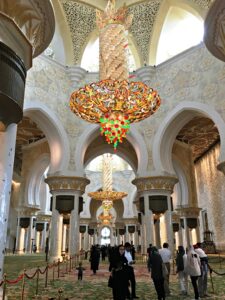 Minaret, a tall, slender tower at corners of the mosque, worshippers are called to prayer from here, it is often the highest point in the area
Minaret, a tall, slender tower at corners of the mosque, worshippers are called to prayer from here, it is often the highest point in the area- Mehrab, a semicircular niche in the wall of a mosque that indicates the direction of the Kaaba in Mecca, the direction that Muslims should face when praying
- Domes above the main prayer hall, signifying the vaults of the heaven and sky
- Prayer hall, with no chairs or pews so as many worshipers as possible can line the room
- Raised areas from which daily prayers are led, or sermons delivered
- Ablution areas where Muslims wash hands, forearm, face and feet before they pray
- Additional facilities from health clinics to libraries to gymnasiums, to serve the community
Certain symbols allude to different aspects of the Islamic religion. One of these is the spiral in reference to heaven as it has “no beginning and no end.” Mosques often have floral patterns or images of fruit and vegetables, allusions to paradise after death.
The Grand Mosque in Abu Dhabi
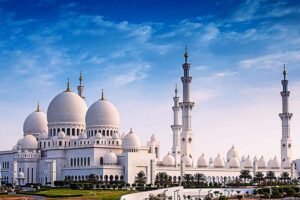 The Grand Mosque in Abu Dhabi is the largest in the country, accommodating over 40,000 worshippers; the main prayer hall can hold over 7,000. There are two smaller prayer halls, with a capacity of 1,500 each, one of which is the women’s prayer hall. Minarets on the four corners of the courtyard are 351 feet in height. The courtyard is 180,000 square feet; its floral design is considered to be the largest example of marble mosaic in the world. The carpet in the main prayer hall measures 60,570 square feet, weighs 35 tons, and was made by 1,300 carpet knotters. The pools along the arcades reflect the mosque’s columns, which are illuminated at night; the lighting system reflects the phases of the moon. The 96 columns in the main prayer hall are marble clad and inlaid with mother of pearl. The 99 qualities or attributes of God (Allah) are featured on the qibla wall in traditional Kufic calligraphy.
The Grand Mosque in Abu Dhabi is the largest in the country, accommodating over 40,000 worshippers; the main prayer hall can hold over 7,000. There are two smaller prayer halls, with a capacity of 1,500 each, one of which is the women’s prayer hall. Minarets on the four corners of the courtyard are 351 feet in height. The courtyard is 180,000 square feet; its floral design is considered to be the largest example of marble mosaic in the world. The carpet in the main prayer hall measures 60,570 square feet, weighs 35 tons, and was made by 1,300 carpet knotters. The pools along the arcades reflect the mosque’s columns, which are illuminated at night; the lighting system reflects the phases of the moon. The 96 columns in the main prayer hall are marble clad and inlaid with mother of pearl. The 99 qualities or attributes of God (Allah) are featured on the qibla wall in traditional Kufic calligraphy.
It seems there’s not much difference in wats and mosques, when you think about what they mean to the people who built them.
» posted on Friday, August 5th, 2022 by Linda Lou Burton
Room With A View
Originally published August 4, 2020 by Linda Lou Burton posting about Bangkok, Thailand from Little Rock, Arkansas – “We were promised rooms with a view of the Arno!” Miss Charlotte fusses, frowning at the ordinary street scene just out the window. Remember the movie Room With a View? Lucy Honeychurch (Helena Bonham Carter) and her spinster chaperone Miss Charlotte (Maggie Smith) enter their hotel room in Florence only to discover they’ve been misassigned. The plot of the movie hinges on that moment, though Miss Lucy claimed the view didn’t matter. Maggie Smith’s chin was set in that Maggie Smith way, insisting that it did most certainly matter; “It’s your first impression of Italy!”
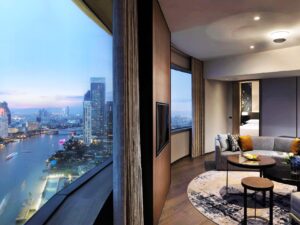 I’m with Miss Charlotte on that point. It matters. All my hotel bookings for the NDI RTW ranked “view” over “cost” in every instance. A view right into Kilauea crater in Hawaii. A view over the harbor in Wellington. A view across the desert to the big red rock in Uluru. A view across the beach to the Indian Ocean in Perth. I like to go to sleep and wake up with priceless images chunking themselves into my memory bank. Store them for later, like maybe when I’m mopping the kitchen floor. Been THERE, my brain reminds me, calling up a visual of the Sahara. Done THAT. This morning, my memory bank is loading up, because Bangkok and the Chao Phraya are just beyond the blink of my eye. Look at what I get to see before I even get out of my pajamas! A panoramic view, as promised.
I’m with Miss Charlotte on that point. It matters. All my hotel bookings for the NDI RTW ranked “view” over “cost” in every instance. A view right into Kilauea crater in Hawaii. A view over the harbor in Wellington. A view across the desert to the big red rock in Uluru. A view across the beach to the Indian Ocean in Perth. I like to go to sleep and wake up with priceless images chunking themselves into my memory bank. Store them for later, like maybe when I’m mopping the kitchen floor. Been THERE, my brain reminds me, calling up a visual of the Sahara. Done THAT. This morning, my memory bank is loading up, because Bangkok and the Chao Phraya are just beyond the blink of my eye. Look at what I get to see before I even get out of my pajamas! A panoramic view, as promised.
This hotel has 533 rooms and a lounge named “360” on the very top of it, so “a view” is there to be had in every direction, all of the time. Just last night I made a late-call on that rooftop 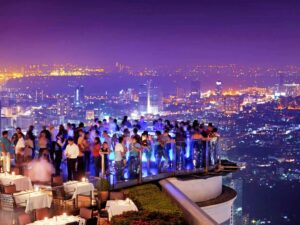 lounge. There is also a rooftop bar “in the open” here, and, I note, there seems to be a competition in Bangkok for the highest space and the widest view. One high-rise bar is named Vertigo!
lounge. There is also a rooftop bar “in the open” here, and, I note, there seems to be a competition in Bangkok for the highest space and the widest view. One high-rise bar is named Vertigo!
But a view doesn’t have to be expansive to be memorable. Some of the best sights are up close and personal, like the view from a longtail boat as you glide through the city’s narrow canals, or klongs. That is your new Thai word for today – klongs.
At One Time It Was Called Venice
 Klong means “canal” and there are 1,682 of them in Bangkok, covering about 1,600 miles. At one time Bangkok had the nickname, “Venice of the East.” Klongs were used for transportation, for floating markets, and yes, for sewage disposal. Today, most of the klongs of Bangkok have been filled in, although the Thonburi side of Bangkok, covering areas west of Chao Phraya River, still retains several of its larger klongs. Klong Saen Saep in central Bangkok is a significant thoroughfare in Bangkok’s public transportation network. The Thai word “klong” is not limited to artificial canals, by the way; many small rivers are referred to as “klongs,” followed by the name of the stream.
Klong means “canal” and there are 1,682 of them in Bangkok, covering about 1,600 miles. At one time Bangkok had the nickname, “Venice of the East.” Klongs were used for transportation, for floating markets, and yes, for sewage disposal. Today, most of the klongs of Bangkok have been filled in, although the Thonburi side of Bangkok, covering areas west of Chao Phraya River, still retains several of its larger klongs. Klong Saen Saep in central Bangkok is a significant thoroughfare in Bangkok’s public transportation network. The Thai word “klong” is not limited to artificial canals, by the way; many small rivers are referred to as “klongs,” followed by the name of the stream.
I Promised I Wouldn’t Talk About Congestion, but
 Even with its many lovely options for water transportation, Bangkok suffers the problems any city has when there are too many cars and not enough roads. Great effort has been made to remedy that with the Bangkok Mass Transit System, commonly known as the BTS or the Skytrain. This elevated system consists of 52 stations along two lines with a combined route length of 33 miles. Bangkok’s rapid transit system also includes the underground and elevated Mass Rapid Transit (MRT) railway lines, the Bus Rapid Transit System (BRT), and the elevated Airport Rail Link (ARL), serving several stations in the city before reaching Suvarnabhumi Airport.
Even with its many lovely options for water transportation, Bangkok suffers the problems any city has when there are too many cars and not enough roads. Great effort has been made to remedy that with the Bangkok Mass Transit System, commonly known as the BTS or the Skytrain. This elevated system consists of 52 stations along two lines with a combined route length of 33 miles. Bangkok’s rapid transit system also includes the underground and elevated Mass Rapid Transit (MRT) railway lines, the Bus Rapid Transit System (BRT), and the elevated Airport Rail Link (ARL), serving several stations in the city before reaching Suvarnabhumi Airport.
Just think, it may be fast-moving, but a ride on an elevated train is an excellent way to see a large city such as Bangkok. Thirty-three miles of looking out your window at a “changing by the second” view.
Lots of images to store in the old memory bank.

